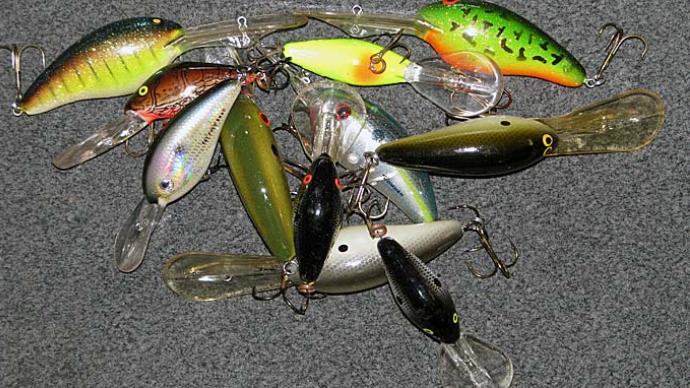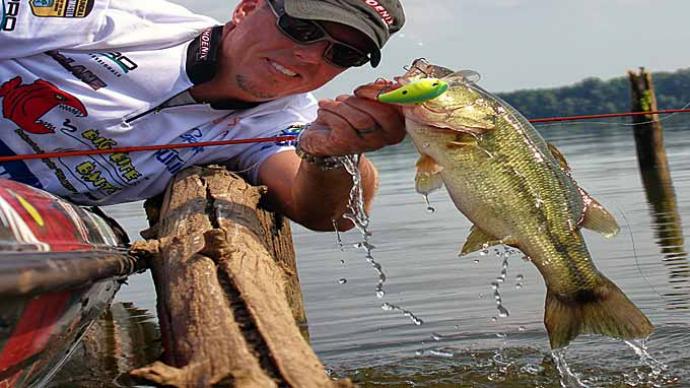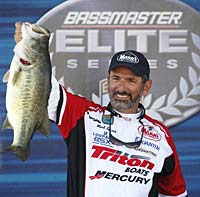
Imagine having a 1982 Bassmaster Classic winner as your personal fishing coach. Envision the record holder for total weight in a four-day B.A.S.S. tournament (132.8 lbs) as your mentor. Hang on to your hats – it's about to happen.
Paul Elias is a legend in the bass fishing world, but a humbler man there never was. With a passion for the sport and a desire to share his gifts of experience and knowledge with others, Paul eagerly took on this writer's challenge: Take a novice bass fisherman to the tackle store, outfit them with the proper equipment, and then coach them in the fundamentals of deep-water structure fishing for bass.
Regardless of your level of competency with a deep diving crankbait, you'll want to come along for the ride, as a crankbait master reveals the secrets that free the novice from the confines of shoreline fishing and opens a whole new world of offshore structure fishing.
Meet Paul Elias
Shake hands with Paul Elias. Relax; this bass fishing legend is as glad to meet you as you are to meet him. He's genuinely excited because he heard you're interested in developing new deep-water crankbait skills. And there's no need to explain. He's already been informed that you're fair with a spinnerbait, plastic worm, or a jig – but your confidence in throwing deep-diving crankbaits isn't where you'd like it to be.
Expect Some Hard Work
With the boat already hooked up, Paul invites you to jump in his vehicle, and it's off to the nearest tackle store to get you set up with the right equipment.
Immediately, our mentor discusses why so few bass anglers are skilled and confident in using deep-diving baits. Paul tells it like it is, "The first thing that I would say is that most bass fishermen are bank-beaters. Most of the time, that eliminates the use of deep-diving crankbaits. Of course, they might have some experience throwing shallower running lures like a lipless crankbait or a Baby 1 Minus, but …the fact is, many fishermen are just lazy. They don't want to crank as hard as is required when fishing deep-diving crankbaits. So they just don't throw them."
This blunt assertion is not without evidence, "I do a fishing school called 'In-depth Fishing,' and I have people come in from all over to attend. When we start the crankbait fishing portion of the class, probably 90% of them comment, 'Man, you must be worn out if you do this all day long.' So I think it's just the lazy side of a bass fisherman who doesn't want to work that hard to catch fish."
Paul's conclusions are also supported by countless tackle boxes across the country that might hold a few deep divers, but they are rarely used. After casting them a while and coming up empty, the owners put them back in the tackle box where they sit while their hooks rust.
Temporarily Focused on Crankbait Fishing Only
To rectify that, our Classic champion is a strong supporter of the learning method that encourages novices to go out on the water intentionally (leaving all other baits at home!) and do nothing else but throw a deep-diving crankbait until they figure out the offshore technique and gain some confidence.
"That's exactly it," says Elias, reflecting on his experiences. "I look back to earlier days in my career when I would never pitch or flip. I wasn't very good at it because I never wanted to do it. So, I would make the same mistakes that most beginning fishermen make. I would do it for a little while, get discouraged, and then return to my favorite routine (a plastic worm, crankbait, or whatever). I just wouldn't do it long enough to get good at it. I would lay it down again if I didn't get a bite right away or within the first 15 or 20 minutes, I would lay it down again."
Some lessons are learned the hard way. "But then, I got badly beaten on Sam Rayburn Reservoir by a Texas angler who was great at flipping. This was back when we used to have to draw tournaments and fish against one another in the boat. I vowed right there and then that I was going to learn how to do this."
"So I came home, and I went into my hallway, which had an 8-foot ceiling, and I took that flipping stick and got good at it. In just a couple of hours, I couldn't believe how much I had improved in just a couple of hours. And then I went fishing several times, and the flipping stick is all I brought. Flipping was all I did until I got good at it. And this holds for learning any fishing technique, including deep-diving crankbaits. If you practice hard enough, you'll get good at it."
Hard Work
Paul's honesty requires balancing his enthusiasm with a sense of reality. "Now granted," he confesses, "offshore structure fishing with deep-diving crankbaits is much harder. Learning to do it eats up a lot of time, and it is hard work." Despite the rewards, he says this kind of commitment and willingness to work hard does not always appeal to most bass fishermen.
This hesitation on the part of anglers to dedicate themselves to the kind of discipline required to learn deep-diving crankbaits is not limited to weekend warriors. Paul points out, "If you look at the stats of many professional fishermen and focus on their answer to this question 'What is your least favorite, or weakest type of fishing?' many pros reply, 'deep diving crankbaits.' And it's because they don't spend enough time with them."
A Different Form of Visualization
Developing deep-water crankbait skills generally requires anglers to abandon the shoreline or bank. Paul is well aware that most bass anglers are very visual and understands that something is enticing about throwing a lure towards a visible target: a lay down, dock, stumps, pilings, rocks, submerged trees, or brush. So, for anglers to get away from the shoreline and venture into deeper water, they must transition to a different form of visualization.
As the vehicle pulls into the parking lot of the tackle store, he explains, "You have to realize when you get away from the shoreline, your lures are your eyes. So is your depth finder. But primarily, your lure tells you what's on the bottom when you're fishing it."
"So you have to picture what that crankbait is doing when diving down there and running over structure or digging into the bottom. (Most of the time, you want to get it digging into the bottom). So when you feel that bait starting to climb over something (hitting a brush pile, stump, or rock pile), it's very similar to your visual shoreline situation. Only now the cover is in deeper water, where you can't see it except with your crankbait."
A Cranking-Action Rod
As you follow Paul into the store, he is a man on a mission. "The first thing I tell beginners to do is get a good cranking-action rod. There are many cranking-action rods on the market now, and I would recommend a 7 to 8-foot rod - whatever a beginner would be most comfortable casting."
In recent years, Paul has worked with Pinnacle and Seeker to produce high-quality 7' 11" foot cranking rods (and reels) to his specifications. For now, you watch as our crankbait master looks through the racks of rods until he finds one with a medium action. And when asked what material is best, he shrugs and says, "I'm 50-50 on graphite or glass."
"The key is to stay within your budget," says Paul, "for financial reasons, I would start the average angler with a graphite composite. And I'd attach that to a 5:1 gear ratio reel to spool that up with Berkley 12-pound fluorocarbon line."
Fluorocarbon Line
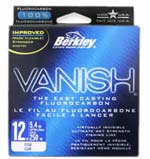
As he hands you the box of fluorocarbon line, he has you read the package until you get to the phrase "non-stretch." Paul explains his choice, "It doesn't stretch like mono, but you have a lot of feel with a fluorocarbon line, and you can stay in touch with the bait a lot better."
"I also believe a crankbait will dive a little deeper because you have less stretch in the line. Fluorocarbon is just a good all-around cranking line."
In recent years, the effects of line diameter on crankbait depth have been a hot issue. But Paul doesn't give it a lot of thought. "I would say the depth difference between 10-pound test and 15-pound test could be in the neighborhood of a foot. I don't feel it's a huge difference (unlike a 3 or 4-foot difference), but there is a difference."
There are a few occasions when Paul goes up or down regarding line size. "It depends on whether I'm trying to get the maximum depth out of the crankbait. If not, I'll step up in line diameter if there's a lot of cover because the bass tend to go in the opposite direction you want them to go. So, if you're fishing submerged trees or brush piles, a fish can break 12-pound test pretty easily. That's when I will jump up to 15 or 17-pound test, and sometimes even 20 (especially if I do not need maximum depth out of that bait). But for open water, 12-pound test is my all-around best diameter."
Glancing at the other lines, Paul adds, "I will use braid in heavy cover. And I will also use braid in the grass a lot because it helps me rip that bait through it." But most of the time, our mentor uses fluorocarbon.
The Concept of "Give" When Fighting Fish
Most crankbait experts talk about the line, reel, and rod working together to provide some "give," which they believe is essential in crankbait fishing. It is also a common opinion that if you don't use monofilament (which stretches) and choose braid or fluorocarbon, you must compensate for those non-stretching lines by having a little softer rod and loosening the drag. Does Paul agree with this assessment?
Undoubtedly, our mentor recognizes the need to provide "give" in the equipment when battling a large fish, but as might be expected, he has a unique perspective on what part the rod and the reel's drag plays when fighting a large fish.
The Rod – A Balance Between "Flexibility" and "Backbone"
Recognizing the rod's role in balancing 'flexibility' with 'backbone,' he explains, "Your rod action needs to be soft for the first 3 feet of the rod. Many cranking rods are a little too soft - especially further down. For good cranking action, it has to have a soft tip in the first top third of the rod, and from there, you have to start building backbone."
"You need a rod tip to load up when you cast the bait. But you also need the power to give it that possibility of loading up so you can cast a deep-diver into the wind. If you have a noodle rod (a rod that's soft down the entire length of the rod), you'll have a tough time casting larger baits in windy conditions."
As Paul heads quickly for the crankbait section of the store, you jump to catch up because he's addressing the concern that some folks have about the rod's softer upper section when it comes to getting a good hookset. "The fish sets the hook," he explains. "Between the fish hitting the lure and your basic reaction to pull back after contact has been made - that's all you need to set the hook on a crankbait."
The Rod – A Balance Between "Give" and "Hook-setting Penetration"

Much has been written by other notable crankbait fishermen emphasizing the need for a rod/reel/line system that provides a lot of "give," which allows a little extra time for a large bass to get the bait back in its mouth so that the hooks can dig in. The fear is that with super sensitive graphite rods and non-stretch lines, anglers react too quickly on the hookset and tend to pull the crankbait out of the fish's mouth before the trebles have a chance to penetrate. On the other hand, an occasional professional such as Rick Clunn claimed to lose too many fish on softer rods and switched to rods that some might consider broom handles.
Paul addresses the controversial issue with the tact of a wise and respected politician who is careful to speak only from their own experience. "While there are times when the rod's action determines whether you hook up with a fish, I believe the rod tip's flexibility comes more into play after you hook up with the fish. I do think when you use a stiffer action rod with treble hooks, there is an increased tendency for fishermen to rip the hooks out of the fish's mouth. But it can be argued that a stiffer rod helps the hooks to penetrate better, …and I believe that's true."
Which way does Paul lean? "Well, I'm on the heavy side of medium when it comes to cranking rods because I believe you get a better hook-up with a little stiffer action rod, but you also sacrifice when that fish gets closer to the boat. (That's when a noodle rod has an advantage)."
"Thumb Spool'in"
So how does Paul compensate for a stiffer rod when playing a large fish up close? "My preference, (when I have a fish closer to the boat) is not to rely on drag. I'd rather push in the release button and 'spool my reel' with my thumb, putting very little pressure on the fish."
If the big bass runs, Paul's thumb immediately eases up, and he lets them take some line, bearing down again when the surge is over.
A search on the internet will take any interested angler to available videos of Paul's record-setting catch of 132.8 pounds in four days on Lake Falcon in 2008. With nearly a 7-pound average, Elias was filmed bringing in monster after monster. Those with a keen eye can observe his thumbing technique whenever a lunker comes near the boat.
"I had a lot of people comment on that video about how many times I 'spooled' my reel, that is, pushed the button on my reel and thumbed the spool when fighting those fish close to the boat. But I feel I've got total control when I do that."
"Otherwise, I'm leaving it to the drag system on the reel. And though I have a lot of confidence in my equipment, I feel something awkward can happen at the wrong moments, especially when a thread barely hooks a fish. Even if you have a loose drag, there isn't enough give when that trophy fish makes a quick lunge, there isn't enough give. If I've got the button released, and I'm thumbing the reel's spool, I can put almost no pressure on that fish if I want to."
The Reel Thing
As he searches the racks of crankbaits with a specific bait in mind, Paul notices you are reading the reel box. As if to read your mind, he comments, "Especially when fishing deeper diving crankbaits, I've found that a 5:1 gear ratio reel is a general all-around good choice."
Often, Paul is asked if the gear ratio makes that much difference in energy spent over a day of crankbait fishing. "I think it does. You have to work a lot harder with a higher gear ratio reels. The 6:1 and 7:1 ratios are just too fast for deep-diving baits. It causes you to fight the bait, and you don't have near the feel. And I also don't think the crankbait gets as deep with the higher gear ratio reels."
Those who have studied the effects of speed on crankbait depth have discovered that when a billed crankbait begins to dig into the water, it creates turbulence. However, excessive speed creates so much turbulence that it decreases the bait's efficiency to move through the water, reducing its depth. This is usually just the opposite of what the average angler expects.
Aware that reel speed is not necessarily a good thing when throwing large-billed deep-divers, he concludes, "The longer it takes to reel that bait in, the deeper that bait can get."
The Deep-diving Crankbait
Among the endless rows of crankbaits, Paul finds what he is looking for among the endless rows of crankbaits. "There are all kinds of makes, models, and depth ranges when it comes to diving baits, but if we're talking about going out and fishing offshore lake structure, it's important to know that the three best-selling deep diving crankbaits on the market are a Mann's 20+, a Norman DD22, and a Pradco Fat-Free Shad."
"My preference (and the reason I've been with Mann's bait Company for 23 years) is the Mann's 20+. And the reason I like a Mann's 20+ is that it has a wider bill and it has a wider wobble. That wider bill allows that bait to go through cover better than the other baits. I also believe the wider wobble in that bait attracts more strikes."
A Wider Bill and Wobble

It's easy to understand what Paul means when he says the wider bill of the Mann's 20+ protects the treble hooks from making contact with wood or snagging other cover. But as to why a wider wobble seems to attract the larger fish...
"You know, I really can't answer that. It just seems that every time I've had several people in the boat, a higher percentage of the time, I will get more strikes on the wider wobbling 20+ than the others. That's not to say 'all the time'. (There are rare occasions when the bass will bite another brand of bait rather than the Mann's). But all around, I seem to catch more big fish on the wider wobbling Mann's 20+ than I do the other baits."
"Nevertheless, in a tournament, I may have all three tied on because I believe that different wobbles and different actions can provoke an additional hit or even several other strikes after you've already caught some fish off of a certain location. So I like to have three different action baits set up."
Is this because Paul thinks bass get acclimated to a certain crankbait running through an area after a while? "I believe fish get acclimated to any type of lure after it's come through an area several times."
A Plug-Knocker
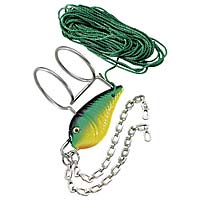
Rod and reel? Check. Line and lures? Check. Are we headed for the checkout counter? Not yet. Paul is well aware that when a newbie takes an expensive crankbait out on the lake only to lose it immediately, that angler gets pretty discouraged. "That's why I recommend getting a good lure retriever or 'plug knocker' in the boat."
As he picks one out and heads for the register, he recognizes that many anglers are on a budget, so he adds this tip, "One of the best and cheapest plug knocker is simply a 3-ounce weight with a swivel attached to it. Just clip it on and let it slide down your line, and 85% of the time, it'll get your plug released." Learning to fish deep structure is a lot more fun when an angler is not losing expensive crankbaits at the bottom of the lake!
Paul throws you the keys and asks you to drive while he sits in the passenger seat and assembles the new rod and reel. The lake is only minutes away, and as he fills the spool with the 12-pound test fluorocarbon line, you keep glancing over to see how he will connect the Mann's 20+ to the line. Will he tie on directly or use a snap?
Like a mind reader, Paul explains, "I tie directly to the split ring, and I use a double improved clinch knot. (Some call it a Berkley Trilene Knot)." Does Paul believe adding a snap is a detriment? "No, many people use snaps, and I don't think it's a problem. But when you use a snap, it's wise to get rid of the split ring, or it's apt to work its way through the split ring. And since most baits come with a split ring, you're either sitting there spending a lot of time taking split rings off all your crankbaits, or you do as I do and just tie directly to your split ring."
On The Lake – Starting With Points
Arriving at the ramp, the boat is quickly loaded and expertly launched. As you idle past the speed buoys, you are overwhelmed by how large the lake is and wonder where a crankbait novice would begin.
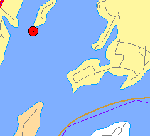
"The easiest thing to do at first," explains Elias, "is to go out on the lake and run points. Look at them carefully with your locator and find the drops on the points. On most lakes, you'll be fishing points that may slowly taper to 12-14 feet and then drop off sharply into 20 feet or even deeper water."
A quick run to the first point, Paul cuts the engine and lowers the trolling motor, explaining that it's a straightforward process. It's best to start on one end of the point, casting all over it from various angles, working your way all around that point. "So you're fishing both sides of the point and the end of that point," says Paul. "And you are going to want to keep in contact with the bottom as much as possible."
Overpowering the Bottom!
How important is contact with the bottom? "It's essential to 'overpower' the water you're fishing. Many people who don't understand crankbaiting will look at a Mann's 20+, and say, 'Since I'm not fishing in 20 feet of water, I don't need that big of a bait.' But a Mann's 20+ is a 14 to 16-foot-deep running bait on a normal cast. Even if I throw that crankbait up into 7 or 8 feet of water and bring it back into 20 or 25 feet of water, I want that bait to get down as quick as possible."
Paul elaborates, "If you take a 7-foot deep running crankbait and throw it up into 7-8 feet of water, it's not going to hit bottom until it's halfway back to the boat. But if you take a crankbait that runs 14-16 feet deep and cast it into 6-8 feet of water, it starts hitting bottom much earlier (before a third of the way back to the boat). And it will probably be at its maximum depth about two-thirds of the way back to the boat. So you want to 'overpower' the bottom so your bait is digging in the bottom as much as possible."
Many beginners often fear that such an "overpowering" of the bottom might scare the bass as the crankbait bounces off rocks, careens off trees, or violently digs up the bottom. Paul assures his students this is not the case, "More often than not, it creates a reaction bite."
Contact!
Anyone who watched Paul on television when he set the world weight record on Lake Falcon noticed he was making long casts and working hard to hit some type of cover on the bottom. There were times when Elias would say, "Darn, I didn't hit it that time." If the observer suspected his comment implied that he did not expect to get hit unless he made contact with the cover on the bottom – they'd be right.
"I was hitting rock." Paul explains, "There was a jagged point sticking out - it was coming off the side of the main point, and the fish were hanging right off those rocks. This was in about 16-17 feet of water. And it's a lot of work to get most of our deep diving baits down to that depth. So that's why I was reaching down, and kneeling-n-reeling, and trying to cast as far as I could. I was sticking an 8-foot rod down in the water up to the reel while cranking to get an extra couple of feet out of that bait."
Contact with the rock was the triggering device, and if Paul missed that rock, the bass would just sit there and watch it go by. Is this an everyday occurrence when crankbaiting? "Yes," stresses Paul. "You have to bounce the bait off whatever's down there. I cannot tell you how often I have found one small piece of cover on a spot, which was the key!"
"And at Lake Falcon, I had to bring a lure from a designated direction and hit those rocks, or the bass wouldn't bite it." Paul recalls he often had to throw the perfect cast maybe ten times or more before it raised a strike, "But it's essential to hit structure and a piece of cover with that crankbait."
The best is yet to come. In Cranking Bass on Deep-Water Structure - The Paul Elias Way - (Part II), our crankbait master explains the techniques for discovering and catching schools of large bass around a single piece of deep cover, when to use the "Kneel-n-reel" method of gaining extra depth, the importance of boat positioning, how to walk a bait over cover, how to pick crankbait colors (and when to change them), how to prevent losing fish, using the proper hooks, whether to use rattles or not, and much more! And... you'll hear about an opportunity to take private lessons from the Classic champion himself.
-------------------------------------------
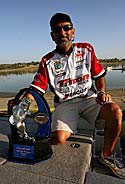
Paul Elias is the 1982 Bassmaster Classic Champion, 15 Time Bassmaster Classic Qualifier, 5 Time FLW Championship Qualifier, and world record holder for total weight in a 4-day tournament (132.8 lbs on Lake Falcon, 2008). His career winnings have now exceeded $1,000,000. He is sponsored by Triton Boats, Honda Marine, Power-Pole, Mann's Bait Company, Berkley, Reel Grip, Lowrance, Costa, Seeker Fishing Rods, and Pinnacle Rods and Reels.


